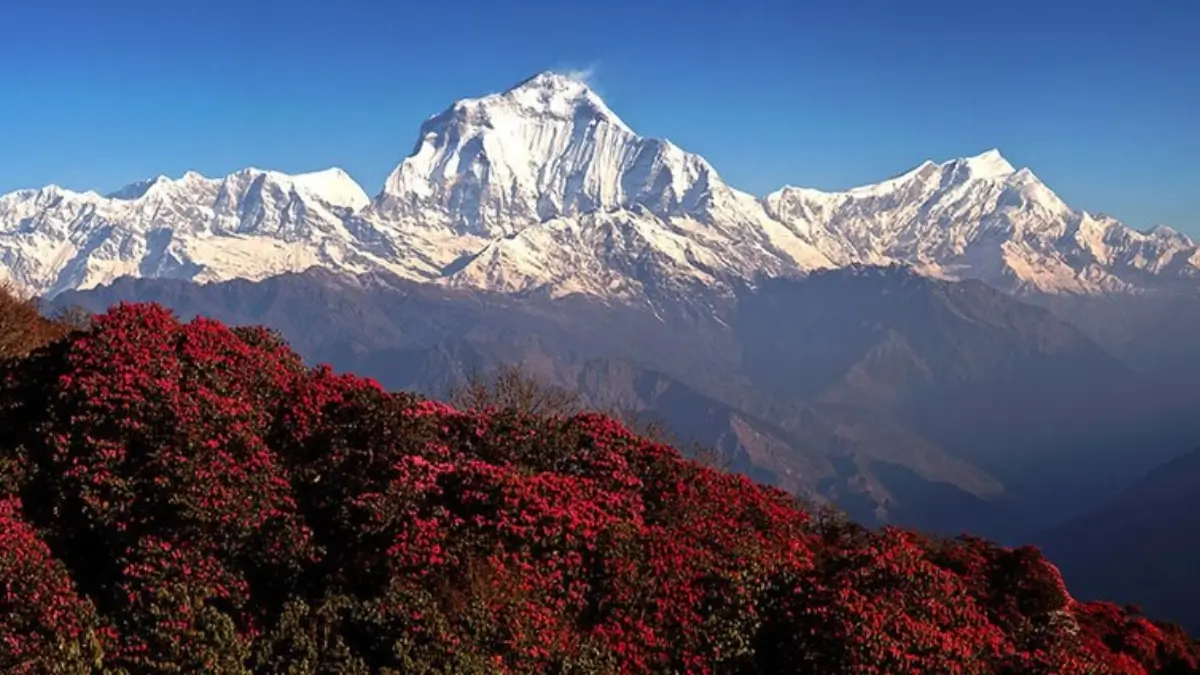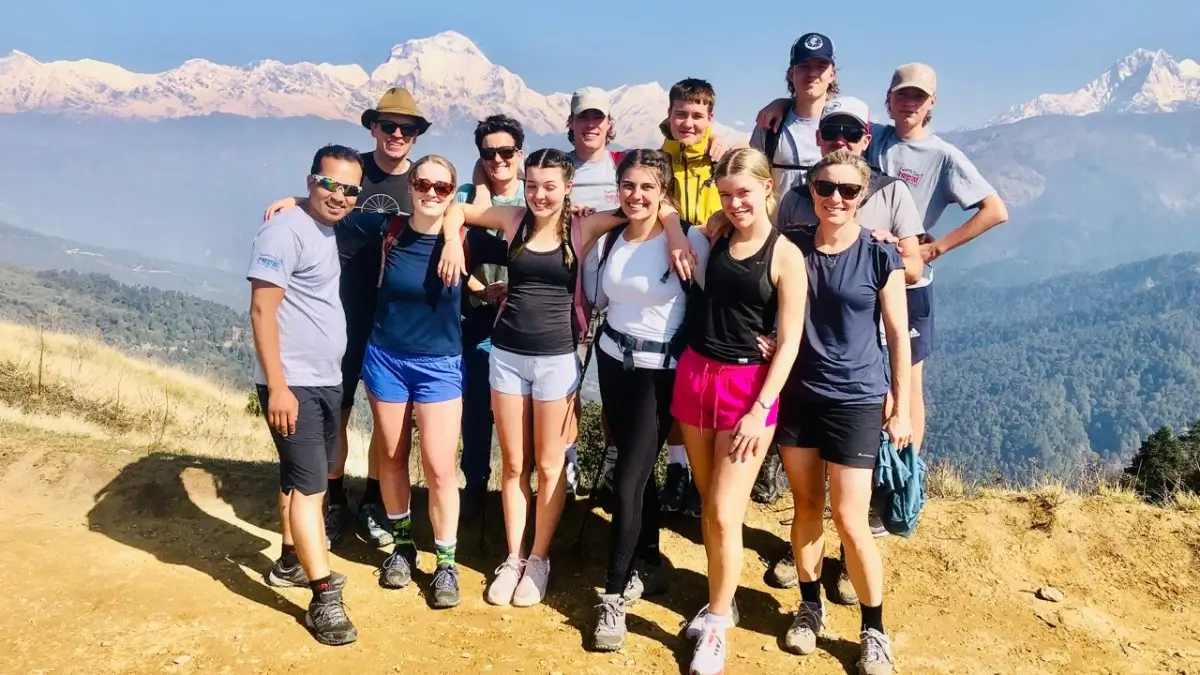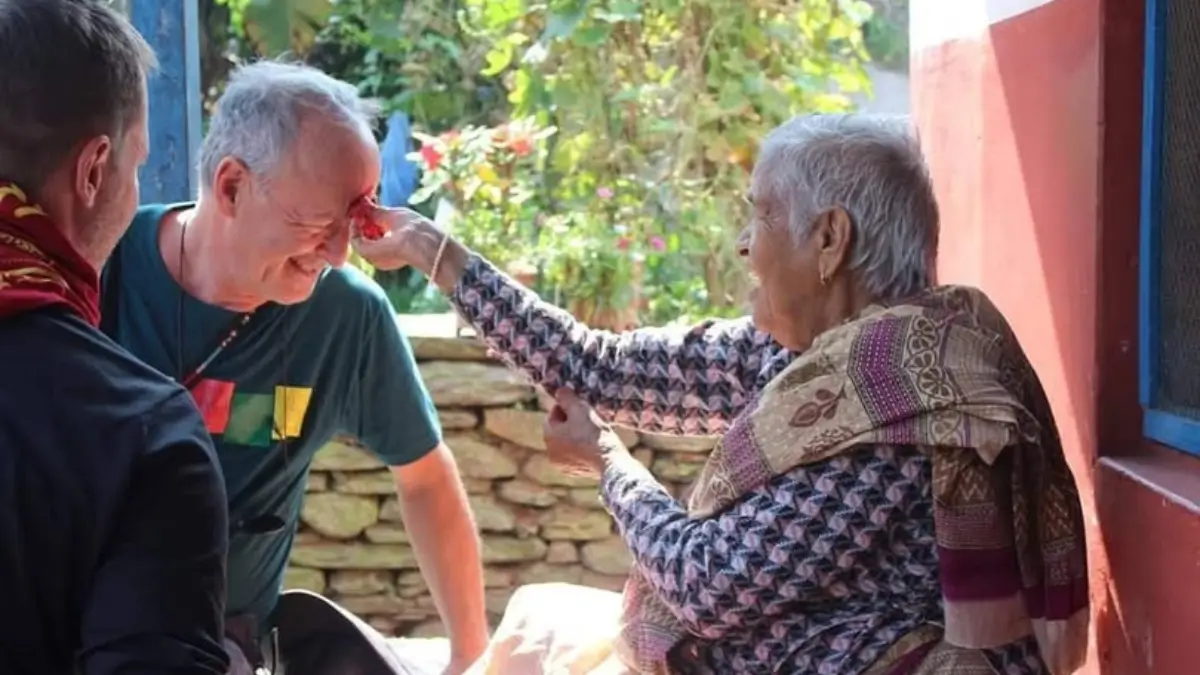The best time for Ghorepani Poon Hill Trek is during Spring and Autumn seasons. This trek gives you amazing sunrise views over the Annapurna and Dhaulagiri ranges, takes you through rhododendron forests and oak and pine trails. It lets you experience life in traditional Gurung and Magar villages like Ghorepani and Ghandruk.
The best time for Ghorepani Poon Hill Trek depends on what kind of weather you like, how crowded you want it to be, and what views you want to see. Every season feels different, from colorful spring flowers to autumn’s clear skies.
Whether you want lively trails or peaceful solitude, understanding Ghorepani Poon Hill trekking seasons helps you pick the best time for Ghorepani Poon Hill Trek.
Seasons of Ghorepani Poon Hill Trek
Choosing the right season for your trek changes everything, from how the trails feel to how many people you’ll meet along the way. Going at the best time for Ghorepani Poon Hill Trek means you get clear mountain views, nice weather, and a better chance to enjoy the local culture and nature.
The season also affects what gear you need to pack, which permits are required, and whether you’ll find busy tea houses or quiet villages along the Modi Khola valley.
Key Seasons
You can do the Ghorepani Poon Hill trek almost any time of the year, but some months are better than others.
- Spring (March-May): Colorful rhododendron flowers everywhere and nice, mild weather
- Autumn (September-November): Clear blue skies and beautiful golden landscapes
- Shoulder Seasons: Early Spring (Feb-Early Mar) and Late Autumn (Late Nov-Dec) have quieter trails with fewer people
- Monsoon (June-August): Green forest views, but lots of rain and slippery paths
- Winter (December-January): Snowy trails, clear skies, and a calm, peaceful vibe
How do Seasons Affect Trekking Experience?
Each season changes the weather, trail conditions, and your whole trekking experience:
- Weather: Temperatures and visibility change a lot depending on the season.
- Trail conditions: Some months have muddy, slippery paths or trails covered in snow.
- Crowd levels: Spring and autumn are the busiest, while monsoon and winter are much quieter.
- Scenic beauty: Each season looks different, from blooming flowers and autumn colors to snowy mountain views.
- Local culture: Some seasons have more festivals and lively village life than others.
Experience the magic of Nepal’s mountains in every season. Join Nepal Gateway Trekking and turn your trek into a memory of a lifetime!
Ghorepani Poonhill Trek in Spring (March to May)- Rhododendron Bloom Season

Spring is one of the best time for Ghorepani Poon Hill Trek. The trails get covered with bright, colorful rhododendron flowers, and the weather is just right, making it comfy to walk long distances.
Weather and Temperature
In spring, temperatures are mild, usually between 10°C and 20°C at lower areas, with cooler nights higher up. The skies are mostly clear, giving amazing mountain views and perfect chances for sunrise photos from Poon Hill.
Nature Highlights
- Trails lined with blooming rhododendron forests
- Green nature valleys with oak and pine paths
- Sunrise views over the Annapurna and Dhaulagiri mountains
Crowd Levels and Experience
- Moderate to high number of trekkers
- Lively trail atmosphere with other adventure seekers
- Tea houses and local services are fully open and running
Your adventure starts here! Let the Ghorepani Poonhill map guide you through one of Nepal’s most scenic treks.
Ghorepani Poonhill Trek in Autumn (September to November) - Clear Mountain Views
Autumn is the best time for Ghorepani Poon Hill Trek because the weather is steady and the air feels fresh, giving some of the clearest mountain views of the year.
Weather and Temperature
- The weather is steady and dry, with daytime temperatures around 15°C to 22°C.
- Mornings and evenings are cool, and the clear skies are perfect for taking photos.
Scenic and Cultural Highlights
- The fields and trees look golden and full.
- You can see local festivals like Dashain and Tihar along the way.
- The weather is perfect for taking wide mountain photos.
Crowd Levels and Experience
- This is the busiest time for trekking, so the trails have more people.
- It’s a good idea to book tea houses early.
Ghorepani Poonhill Trek in Shoulder Seasons - Quiet Trails

For trekkers who want some peace and quiet or special photo opportunities, the shoulder seasons are perfect. The route is less crowded, so you can enjoy nature and the mountains without too many people around.
Early Spring (February to Early March)
- The weather is cooler, and some parts of the trail can be a little icy.
- There are fewer trekkers, so the trail feels peaceful.
- Early rhododendron flowers start to bloom along the way.
Late Autumn (Late November to December)
- The trails are lined with golden leaves.
- It’s early winter, so the mornings feel crisp and fresh.
- Perfect time for a quiet trek and enjoying some alone time in nature.
Preparation and Packing Tips
- Wear layers so you stay warm in the cold mornings and comfortable in the warmer afternoons.
- Bring trekking poles for the icy parts of the trail.
- It’s the perfect time for people who love taking photos or want some peace and quiet.
Ghorepani Poonhill Trek in Monsoon (June to August) - Lush Scenery and Challenges
During the monsoon, the area transforms into a green forest paradise, but it also brings some extra challenges. Here are a few things you should take note of when trekking in the monsoon season.
Weather and Trail Conditions
- There’s heavy rain, slippery paths, and the risk of landslides.
- It’s humid, and sometimes parts of the trail can get flooded.
Nature and Wildlife
- The trails are surrounded by bright green plants and thick forests.
- Plants and animals are at their best during the monsoon.
Safety and Accommodation
- You can find regular tea houses, but some faraway lodges might be closed.
- You need to be careful because the paths are wet and slippery.
- This season is best for experienced trekkers who don’t mind the rain.
The Annapurna region offers countless trekking options beyond Ghorepani. Nepal Gateway Trekking, your Annapurna Trek Agency, has been creating unforgettable Himalayan adventures for decades!
Ghorepani Poonhill Trek in Winter (December and January) - Snow and Solitude
Winter is a peaceful time for trekking, with clear skies, fresh crisp air, and very few people on the trails.
Weather and Temperature
- Nights are cold, with temperatures reaching around 0°C to -5°C, and there is snow at higher spots.
- The mornings are a bit on the cold side, but crisp and perfect for sunrise photos.
Trail and Crowd Conditions
- There are fewer trekkers, so the trail will be quiet and peaceful.
- Some services might be limited due to the cold, so it’s important to plan ahead.
Gear and Preparation
- You need warm clothes, insulated gear, and winter boots.
- Be careful on the icy parts of the trail.
Peak and Off-Peak Seasons for Ghorepani Poonhill Trek
Peak season is when most people go trekking, so the trails and tea houses are busier. Off-peak season is when fewer trekkers visit, making the trails quieter and often giving a more peaceful experience.
Knowing the busy and quiet times helps you plan your budget, where to stay, and what your trekking experience will be like.
Peak Seasons Spring and Autumn
- Benefits: Clear skies, all tea houses open, rhododendron flowers in bloom, and great for photography.
- Drawbacks: Trails are crowded, costs are higher, and you need to book early.
Off Peak Seasons Monsoon and Winter
- Benefits: Quiet trails, cheaper, and perfect for nature lovers who want some alone time.
- Drawbacks: Weather can be tough, and some facilities might be limited.
Your ideal trekking season awaits. Dive into Nepal Gateway Trekking's guide and choose the best trekking season in Nepal for your lifetime memory.
Special Festivals Focus Season Trekking for Ghorepani Poon Hill

Trekking during festival times gives you the honour of watching local festive culture along the trail. You can enjoy colorful celebrations, traditional music, and local food while trekking.
Dashain
Dashain happens around September to October during autumn and is the biggest Hindu festival in Nepal. Families come together, sacrifice animals, and have fun playing swings. Hiking during Dashain is a cool way to see these traditions and feel the fun festival vibes in the villages along the way while getting a close look at Nepalese culture.
Add in: Image of Dashain festival en route
Tihar
Tihar happens around October to November during autumn and is known as the Festival of Lights. People show respect to animals like crows, dogs, cows, and oxen, and the festival ends with a special day where brothers and sisters celebrate with each other by giving blessing and gifting sweets and items.
Trekking during Tihar is extra special because the villages along the trail are decorated with lights and oil lamps, making everything look colorful and welcoming while letting you experience Nepalese traditions up close.
Add in: Image of Tihar Festival en route
Holi
Holi happens in March during spring and is a festival of colors. In this festival, people throw colored powders and water balloons at each other for fun. Trekking during Holi is fun as you can join the celebrations. Especially in Gurung and Magar villages, where traditional dances and songs make the festival even more joyful and memorable.
Tamu Lhosar (Gurung New Year)
Tamu Lhosar happens from December to January in winter and is the Gurung New Year. People celebrate with traditional dances, songs, and community gatherings. Trekking during Tamu Lhosar lets you see the colorful and lively celebrations of the Gurung community in the villages along the trail.
Maghe Sankranti
Maghe Sankranti happens in January during winter and is a festival of the Magar community that marks the end of winter and the start of warmer days. Trekking during Maghe Sankranti lets you experience the Magar community’s traditional rituals, dances, and feasts in the villages along the trail.
Festival season is the perfect time to trek Ghorepani Poon Hill ! Secure your trek now with Nepal Gateway Trekking and experience the Himalayas like never before.
How to Choose the Best Time for Ghorepani Poon Hill Trek?
Choosing the best time for Ghorepani Poon Hill Trek can really change how much you enjoy it. Consider the weather, trail conditions, and the type of experience you’re looking for before making your plans.
- Weather preferences: Clear skies are best in spring and autumn, while occasional rain comes in the monsoon and snow in winter.
- Crowd tolerance: Peak seasons have busier trails, while off-peak seasons offer solitude.
- Budget: Off-peak seasons are usually more affordable for accommodations and services.
- Scenic priorities: Spring has rhododendron blooms, autumn shows colorful foliage, and winter offers snowy landscapes.
- Safety: Monsoon trails can be slippery and risky for inexperienced trekkers.
Packing Guide by Season
Packing the right gear for each season keeps you safe and comfortable on your trek. Here’s an easy guide to help you get ready for any time of year.
Spring and Autumn
- Wear lightweight trekking clothes that you can layer for random weather changes.
- Bring softened trekking boots, sun protection, and trekking poles for support.
Monsoon
- Waterproof jackets, pants, a windproof jacket, and boots to stay warm and dry.
- Use rain covers for your backpack and electronics to protect them from water.
Winter
- Pack insulated jackets, gloves, hats, and thermal clothes to stay warm.
- Bring winter trekking boots and warm sleeping gear for cold nights.
Optional Items
- Photography gear to capture the stunning and breathtaking panoramic views.
- Bring your matching power socket, filtered water bottles, and snacks for the trail.
Explore Our Ghorepani Poonhill Trek - 8 Days Package.
Final Thoughts
The best time for Ghorepani Poon Hill Trek depends on what kind of experience you want from this trek. Choose Spring and autumn if you want clear skies and colorful landscapes. Or you can go with shoulder seasons and winter which offers quiet and peaceful trails. As for Monsoon, it brings green forests and wildlife, but can be more challenging.
Start planning your trek now, thinking about your weather, crowd, and scenery preferences. Nepal Gateway Trekking can help you organize a safe and unforgettable adventure for the season you choose.
Get ready for your Himalayan journey, contact Nepal Gateway Trekking now!
FAQ
How difficult is the Ghorepani Poon Hill trek?
The trek is easy to moderate and good for beginners. Most days involve 3 to 6 hours of walking, with some steep parts like the climb to Poon Hill (3,210 meters). The trails are clear but can be slippery in the monsoon or winter, so wearing good trekking boots and keeping a steady pace is important.
What is the highest altitude on the Ghorepani Poon Hill trek?
The highest spot is Poon Hill, which is 3,210 meters (10,531 feet) high. From there, you can see amazing sunrise views of the Annapurna and Dhaulagiri mountains. You might feel a bit weird because of the height, so take it slow and drink lots of water.
How long does it take to complete the Ghorepani Poon Hill trek?
A normal trek takes around 5 to 7 days. Most people start from Nayapul, go through the villages of Ghorepani and Ghandruk, and then come back to Nayapul. You can add a few more days if you want to take pictures, learn about the local culture, or join in on festivals.
Do I need a guide for the Ghorepani Poon Hill trek?
If you’ve done trekking before, you don’t really need a guide, but if it’s your first time, it’s a really good idea to have one. Guides help keep you safe, find places to stay, handle permits, and teach you about the local culture.
What permits are required for the Ghorepani Poon Hill trek?
You need an ACAP permit to enter the Annapurna Conservation Area, and a TIMS card to help keep track of trekkers for safety. You can get these permits in Pokhara, Kathmandu, or from your trekking agency.
What is the accommodation like during the Ghorepani Poon Hill trek?
You’ll mostly stay in tea houses that have basic rooms, blankets, and food. During busy seasons, it’s best to book early. Some places have hot showers and Wi-Fi, but things might not work as well during the rainy season or winter.
Can I trek Ghorepani Poon Hill independently without a guide?
Yes, the trail is easy to follow, but if you’re trekking on your own, you should bring maps, permits, and the right gear. Having a guide makes things safer, teaches you about the local culture, and can help if something goes wrong.
What gear should I bring for the Ghorepani Poon Hill trek?
Things you really need: trekking boots, clothes you can wear in layers, rain gear if it’s monsoon season, warm clothes if it’s winter (Dec-Jan), trekking poles, and a backpack with water and snacks. Optional stuff: a camera and a small first-aid kit.
When is the best time to trek for rhododendron bloom?
The best time to see rhododendrons in full bloom is in spring (March to May), especially in March and April. The trails are super colorful, and the forests near Ghorepani and Modi Khola valley look the brightest.
Is it safe for solo female trekkers to trek Ghorepani Poonhill?
Yes, Ghorepani Poon Hill is usually safe for girls trekking alone. Just stay on the main trails, book your tea houses early, and think about getting a local guide to help you stay safe and learn more about the culture.
How can I prepare physically for the trek?
You should be a bit fit for this easy to medium hike. To get ready, try doing some cardio like walking, jogging, or skipping to build up your energy. Also, make your legs stronger by doing squats, lunges, and going up stairs. It’s a good idea to do 2 to 3 practice hikes with a backpack before the trip so your body gets used to it.





